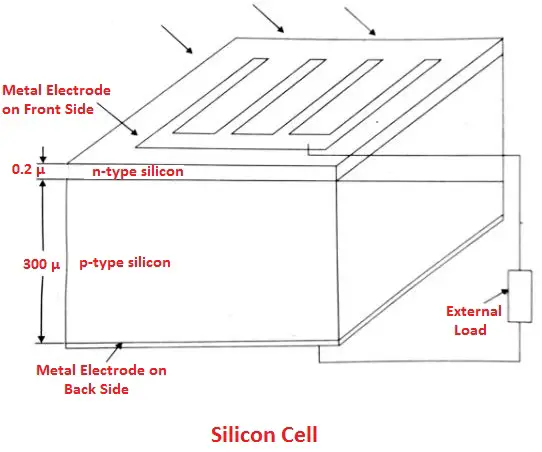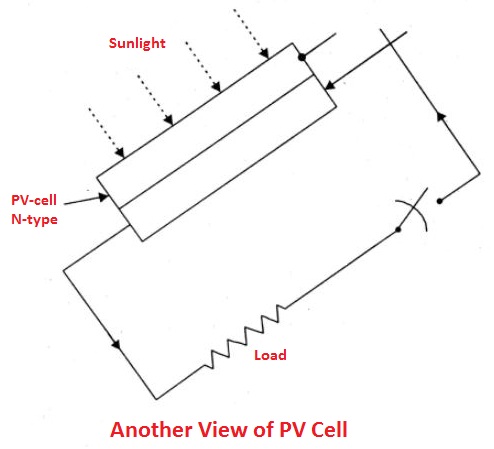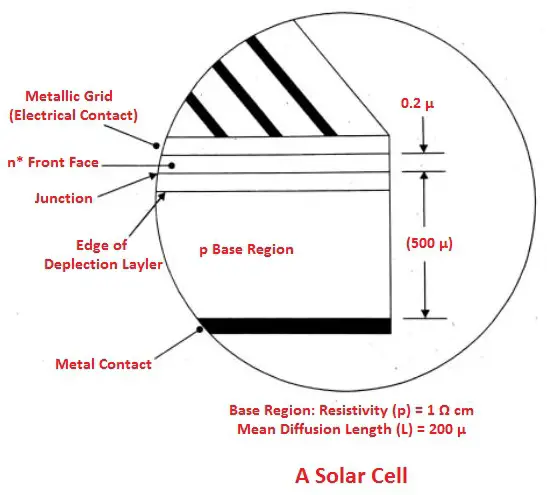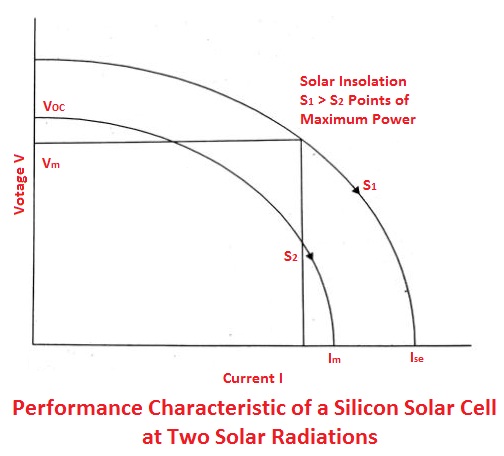In this article, you’ll learn about solar cells and their working principle, different types of solar cells, Their construction and application of solar cells. Also, download the free PDF file of this article.
What is a Solar Cell?
In photovoltaic (PV) conversion, solar radiation falls on semiconductor devices called solar cells which convert the sunlight directly into electricity.
A schematic diagram of a photovoltaic cell (PV cell) or solar cell is given in the figure.

It relies on light, which affects the junction between two types of semiconductors called p-type and n-type. The N-type has excess electrons and the p-type has a shortage of electrons.
When a bright light shines on a cell, the energy from the light i.e. photon enables the electrons to break free from the junction between them.
This is called the photoelectric For single-crystal silicon (4 valence electrons), ‘p’ is obtained by doping silicon with boron (3 valence electrons) and is typically 1 um thick; ‘n’ is obtained by doping with arsenic or phosphorous (5 valence electrons) and is typically 800 um thick.

Read also: What is Solar Panel? Their Types, Working, Advantages, and More
Types of Solar Cells
Following are the different types of solar cells used in the solar panels:
- Amorphous silicon solar cells (a-Si).
- Biohybrid solar cell.
- Buried contact solar cell.
- Cadmium telluride solar cell (Cd Te).
- Concentrated PV Cell (CVP and HCVP).
- Copper Indium Gallium selenide solar cells (CI(G)S).
- Crystalline silicon solar cell (C-Si).
- Dye-sensitised solar cell.
- Hybrid solar cell.
- Multi-junction solar cell.
- Monocrystalline solar cell.
- Nano-crystal solar cell.
- Photoelectrochemical cell.
- Solid-state solar cell.
- Thin-Film solar cell.
- Wafer based solar cells.
#1 Amorphous Silicon Solar Cells (a-Si)
These are modified versions of thin-film solar cells. This type of solar cell uses three layers of amorphous silicon so that each has different bandgap energy. The different bandgaps allow each layer to respond to a different part of the Sun’s energy spectrum as a way of boosting conversion efficiency.
Amorphous cells offer higher efficiency than other types and are readily available. But, they require twice the surface area to produce the same power as a monocrystalline solar cell.
#2 Biohybrid Solar Cell
Biohybrid solar cells are composed of organic matter (containing carbon) that is photosystem and inorganic matter (not carbon). Several layers of the photosystem collect photonic energy, it converts into chemical energy and creates a current that passes through the cell.
The main advantage of a biohybrid solar cell is that it converts solar energy into electricity with 100% efficiency. This means that little or no power is lost through the change from chemical to electrical power.
#3 Buried Contact Solar Cell
The buried contact solar cell is a high-efficiency solar cell technology. These types are operated based on a plated metal contact inside a laser-formed groove.
They can give a better performance of about 25% compared to commercial screen-printed solar cells. The efficiency gains in buried contact technology provide substantial cost and performance benefits.
#4 Cadmium Telluride Solar Cell (Cd Te)
This type of solar cell uses cadmium telluride in a thin semiconductor layer that is designed to absorb and convert sunlight into electricity. These act as the primary photo-conversion layer and absorb the most visible light within the first micron of the material.
In which the TCO layer creates an electric field that converts the light absorbed in the CdTe layer into current and voltage. These systems are much more efficient than comparable crystalline silicon.
#5 Concentrated PV Cell (CVP and HCVP)
Concentrated PV cells generate electrical energy in the same way as conventional photovoltaic systems. CVP typically uses curved mirrors to focus sunlight onto small, highly efficient, multi-junction solar cells. These can provide greater efficiency of about 40% and are also cheaper.
#6 Copper Indium Gallium Selenide Solar Cells (CI(G)S)
A copper indium gallium selenide solar cell is used to convert sunlight energy into electrical energy. It is usually made by depositing a thin layer of copper, indium, gallium, and selenium on a glass or plastic backing, along with electrodes back and forth to store the current.
Since the material has a high absorption coefficient and strongly absorbs sunlight, a much thinner film is required. These materials can absorb a significant portion of the solar spectrum, allowing them to achieve the highest efficiency.
#7 Crystalline Silicon Solar Cell (C-Si)
Crystalline silicon is the major semiconductor material used in photovoltaic technology for producing solar cells. These solar cells are composed of silicon particles linked together to form a crystal lattice.
This crystal lattice provides an organized system that makes the conversion of light into electricity more efficient. Since it has high efficiency, it reduces the cost of the final installation.
#8 Dye-sensitised Solar Cell
It is a low-cost thin-film solar cell based on a semiconductor formed between a photo-sensitive anode and an electrolyte, a photoelectrochemical system. These devices are used to convert light energy into electrical energy by the use of organic dyes and semiconductors.
Compared to other types of solar cells, they act better under high-temperature conditions and diffused light. In addition, it is cost-effective, easy to manufacture, and simple to manipulate.
#9 Hybrid Solar Cell
These types of solar cells consist of two materials, organic and inorganic semiconductors. The organic material consists of conjugated polymers that absorb light as donors and transport pores.
On the other hand, inorganic materials are used as acceptors and electron transporters in the structure. The advantage of hybrid solar systems is that they store solar energy and low-cost electricity. The use of solar energy has been made possible during maximum usage time.
#10 Multi-junction Solar Cell
These are solar cells with multiple p-n junctions made of various semiconductor materials. In this, the p-n junction of each material will generate an electric current in response to different wavelengths of light.
These can absorb different wavelengths of incoming sunlight using separate layers. This makes them more efficient at converting sunlight into electricity than single-junction cells.
#11 Monocrystalline Solar Cell
This type of solar cell is composed of a cylindrical silicon bar made from a single crystal of silicon of high purity similar to that of a semiconductor. It works like a polycrystalline solar cell.
When sunlight falls on monocrystalline solar cells, they absorb the energy, and through a complex process create an electric field. This electric field includes the voltage and current that generate electricity. Monocrystalline solar cells have relatively high efficiency.
#12 Nanocrystal Solar Cell
The nanocrystal solar cells are made of a material coated with nanocrystals. The nanocrystals are of silicon, CdTe, or SiGs and the substrates are usually silicon or various organic semiconductors.
These nanocrystals are formed by a spin-coating process that involves placing a volume of quantum dot solution onto a flat surface. The solution is spread evenly, and the surface is turned until the required thickness is achieved.
#13 Photoelectrochemical Cell
These solar cells absorb a source of sunlight onto a semiconductor or photosensitizer to produce electrical energy, similar to a dye-sensitized solar cell.
In this, each cell consists of one or two semiconductor photoelectrodes and also an additional metal and reference electrode dipped in an electrolyte. These are low in cost and a fairly easy process which is one of its advantages.
#14 Solid-state Solar Cell
Solid-state solar cells are typically used for semiconductor equipment similar to semiconductor diodes and integrated circuits. They are also used in semiconductor electronics with no moving parts replacing devices with moving parts.
It consists of two crystals, one doped with an n-type semiconductor that amplifies additional free conduction band electrons. The other is doped with a p-type semiconductor which adds more electron holes.
#15 Thin-Film Solar Cell
These types are designed to convert sunlight energy into electrical energy by using a photovoltaic effect. Thin-film solar cells are made by depositing one or more thin layers on a flexible substrate, such as glass, plastic, or metal.
Nowadays, various types of thin-film solar cells are used due to their relatively low cost and their efficiency in power generation. Also, these are used in several technologies including cadmium telluride, copper indium gallium diselenide, and amorphous thin-film silicon.
#16 Wafer-based Solar Cells
As the name suggests, Wafer-based silicon cells are made of slices of single-crystal or multi-crystalline silicon. They can achieve the highest efficiency of any type of photovoltaic technology. In this solar cell, all functional layers are deposited on the substrate and transcribed to separate the electrically connected subcells.
Working of Solar Cell
The sun’s photons strike the cell on the microthin p-side and penetrate the junction to generate the electron-hole pairs. When the cell is connected to a load, as shown, the electrons will diffuse from n top. The direction of the current (I) is in the opposite direction of the electrons.
Typically voltage-current characteristics are shown in the figure at two different solar radiation levels, for each of which Voc = open-circuit voltage, Isc = short-circuit current. The ideal power of the cell is Vo.Is. The maximum useful power is the area of the largest rectangle that can be formed under the I-V curve.

If the voltage and current corresponding to this situation are denoted by Vm and I’m then the maximum useful power is VmIm. The ratio of the maximum useful power to the ideal power is called the full factor (k). Typical values of these factors for a silicon cell are:
Voc = 450 to 400 mV; Ioc = 30 to 50 mA/cm2, K = 0.65 to 0.80.
Solar cells in the form of thin films or wafers convert from 3% to less than 30% of incident solar energy into d.c. electricity. The connection of such cells into series-parallel configurations permits the design of solar panels with high voltages as high as several kilovolts.

Combined with energy storage and power-conditioning equipment, these cells can be used as an integral part of a complete solar-electric conversion system.
Applications of Solar Cells
There are many practical applications for the use of solar panels or photovoltaics. It is first used in agriculture as a power source for irrigation. In health care, solar panels can be used to refrigerate medical supplies. PV modules are utilized in photovoltaic systems and include a large type of electric devices:
Following are the different lists of applications of solar cells:
- Photovoltaic power stations.
- Rooftop solar PV systems.
- Standalone PV systems.
- Solar hybrid power systems.
- Concentrated photovoltaics.
- Solar panels.
- In solar-pumped lasers.
- Solar vehicles.
- Used in solar panels on space crafts and space stations.
That’s it, thanks for reading. If you have any questions on “types of solar cells” ask in the comments. If you like this article please share it with your friends.
Subscribe to our newsletter for more content:
Download PDF of this article:
Read Next:
- Solar Power Plant: It’s Working and Types of Solar Power Plant
- A.C Motors: Parts, Types, Working, Applications, Advantages
- Electric Circuit: Types of circuits with [Pitures & PDF]
Reference:
FAQs
Three main categories of solar cells exist thin-film solar cells, crystalline silicon-based solar cells, and a more recent mix of the first two.
Typically, monocrystalline panels are the most efficient and powerful. They have a power capacity of more than 300 watts (W) and can achieve efficiencies of more than 22%. However, polycrystalline solar panels typically have lower wattages and rarely surpass 17% efficiency.
Since monocrystalline solar panels generate more electricity on a smaller scale than polycrystalline solar panels, they are ideal for locations with limited space.
This is frequently expressed in kWh or kilowatt-hours. A typical battery has a capacity of 10 kWh. A fully charged 10 kWh battery should be enough to power your home for a full day during a power outage. But it’s crucial to avoid using up the battery’s entire energy.
what about printed solar cells
are they efficient ? Whether they require minimum area ?
Printed solar cells are a promising technology, but their efficiency varies. While some printed solar cells have achieved decent efficiency levels, they are generally not as efficient as traditional silicon-based solar cells. As for the area requirement, printed solar cells can be designed to be flexible and can potentially cover large surfaces, but the specific minimum area required would depend on the design and efficiency of the cells.
Please send me the pdf
The PDF file has been sent to your inbox.
Please send me the pdf [email protected]
The PDF file has been sent to your inbox.